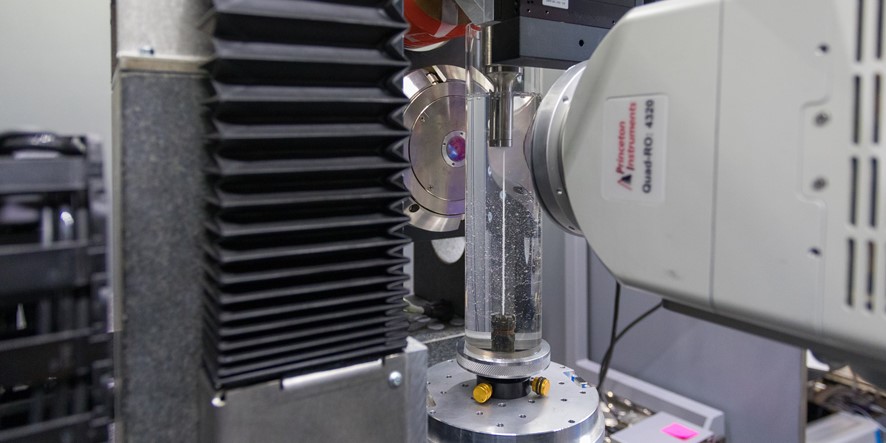Sintering is a major step in powder metallurgy and ceramics processing. Our works aim at understanding the links between processing parameters, involved mechanisms and microstructure changes, in order to optimize the process and control the microstructure. Part the work is focused on field assisted fast sintering techniques: induction sintering, microwave sintering and “flash sintering”. This includes experimental and modelling tool development and investigation of academic or industry oriented issues.
Objectives
Our research aims at understanding sintering mechanisms in both conventional and field assisted sintering techniques. A major challenge in the recent years has been to develop an experience and specific devices for a comprehensive study of various field assisted sintering techniques. Besides their ability to ensure very fast heating, these techniques enable heating by direct interaction between the electromagnetic field and the powder compact. This offers opportunities for enhancement or inhibition of internal sintering mechanisms. Exploring these possibilities was one of our major concerns.
A midterm objective is to apply these techniques, in particular their selectivity, to develop the co-sintering of multimaterial parts in metal-metal, ceramic-ceramic and metal-ceramic systems.
Conventional sintering
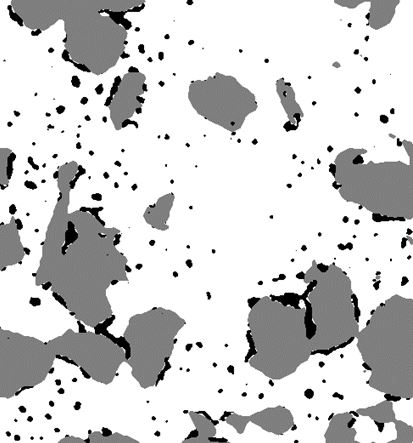
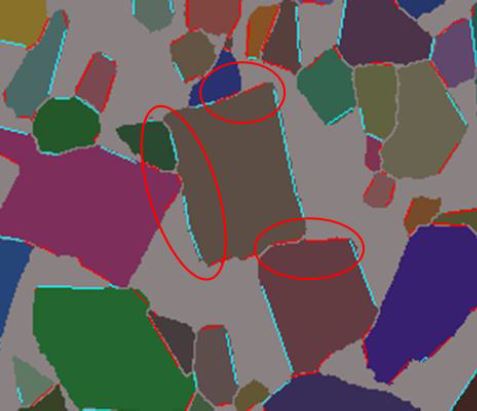
Pore localization in Cu-Cr sintered composites and contact (left), and local grain boundaries and interfaces in WC-Co composites (right).
Experimental investigations uses classic and optical dilatometry, completed by other techniques such as differential thermal analysis and thermos-gravimetry for conventional sintering. Part of the research is driven by industrial needs, often throughout long term partnership. Among them: liquid phase sintered WC-Co, silver base and Cu base composites for electrical contacts and NdFeB magnets. We also work on the processing of materials with controlled porosity for various applications (fuel cells, heat exchangers, bone implants). Conventional sintering data provide references for identifying distinctive effects of field assisted sintering techniques. Modelling efforts include finite element analysis to predict dimensional changes and internal stresses, discrete element simulation to investigate particle interactions and analytical models to identify sintering mechanisms.
Induction and microwave sintering
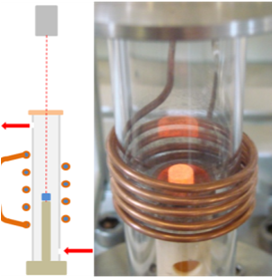
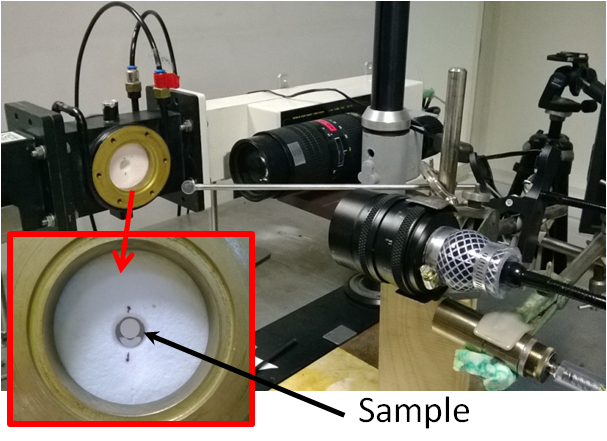
Direct induction sintering (left) and microwave sintering (right) devices
A specific device for direct induction heating of compacts has been developed, enabling heating rates up to 1000°C/min. It allowed finding out original effects due to electric current in Ni and to high heating rate in Ag base alloys.
Microwave sinterin is particularly adapted to ceramics, which dissipate heat from microwaves through dielectric losses. The device was recently equipped to perform optical dilatometry and modified to allow direct heating (without “susceptor”) of ceramics and even metals. Sinter forging is also possible. Recent results include the direct heating of pure alumina, while all previous works needed a susceptor or a significant amount of additive elements, the evidence of specific microwave effects in alumina sintering in early stages of densification (150°C shift in starting temperature), and the strong effect of microwaves on the g à a phase transition. Using MgO doped alumina, we showed that microwaves mainly impact mechanisms at grain boundaries.
FEM modelling is used to calculate the electrical field in the cavity as function of process parameters (sample geometry and properties, insulating parts, susceptor, if any) and thus optimize the process. Coupling with thermal and mechanical (shrinkage) phenomena is in progress.
Flash Sintering
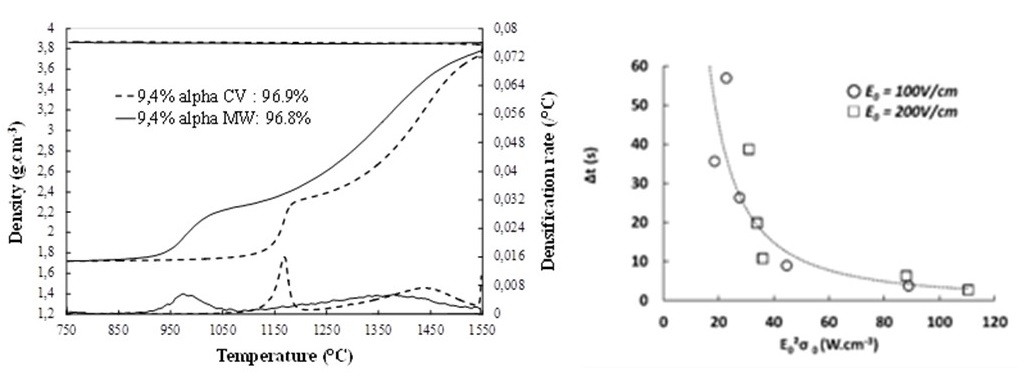
Effect of microwave on the gàa transition during sintering of g alumina (left); time incubation vs. Joule power E2seff in flash sintering (right)
Flash Sintering, which is observed in ionic conductive ceramics, leads to abrupt increase in current with densification in a few seconds when a field is applied to a preheated ceramic sample. Associated with LEPMI lab and using yttria doped zirconia and alumina-zirconia microcomposites, we showed that effective conductivity seff and electric field E, through the Joule power E²seff, drives the phenomenon, which can mainly be attributed to electro-thermal runaway. Estimated temperatures were confirmed by microstructural observation.
- Effect of binder composition on WC grain growth in cemented carbides. M. Pellan, S. Lay, J.-M. Missiaen, S. Norgren, J. Angseryd, E. Corone, T. Persson. J.Am. Ceram. Soc. 98(11), 3596–3601 (2015)
- Numerical and experimental analysis of the effect of pore formers on the processing and properties of solid oxide fuel cell electrode. T. Reynier, C.L. Martin, D. Bouvard, C.P. Carry, R. Laucournet, Journal of the European Ceramic Society 35, 2523–2530 (2015)
- Deformation and cracking during sintering of bimaterial components processed from ceramic and metal powder mixes. Part II: Numerical simulation, G. Largiller, L. Dong, D. Bouvard, C.P. Carry, A. Gabriel, Mechanics of Materials 53, 132–141 (2012).
- Investigation of the sintering of heterogeneous powder systems by synchrotron microtomography and discrete element simulation. L. Olmos, C.L. Martin, D. Bouvard, D. Bellet, M. Di Michiel, Journal of the American Ceramic Society 92, 1492-1499 (2009)
- Densification and microstructure changes of micron-size nickel powder during direct induction sintering. A. Guyon, D. Bouvard, J.M. Chaix, C.P. Carry, Powder Metallurgy, 57 (1), 54-60 (2014)
- Development of an instrumented and automated single-mode cavity for ceramic microwave sintering: application to an alpha pure alumina powder. J. Croquesel, D. Bouvard, J-M. Chaix, P. Carry, S.Saunier. Materials and Design, 88, 98–105 (2015)
- Microwave sinter forging of alumina powder. V. Delobelle, J.Croquesel, D.Bouvard, J.M.Chaix, C.P.Carry Ceramics International 41 7910–7915 (2015)
- Flash sintering incubation in Al2O3/TZP composites. E.Bichaud, J.M. Chaix, C. Carry, M. Kleitz, M.C. Steil Journal of the European Ceramic Society 35, 2587–2592 (2015).
- Delannay F, Missiaen J-M. Assessment of solid state and liquid phase sintering models by comparison of isothermal densification kinetics in W and W-Cu systems. Acta Mater. Elsevier Ltd; 2016;106:22–31.
- Z. Yan, O. Guillon, C.L. Martin, S. Wang, C.-S. Lee, and D. Bouvard, In-situ synchrotron x-ray transmission microscopy of the sintering of multilayers, Appl. Phys. Lett., 102 223107 (2013).
Research Staff
- D. Bouvard
- J.-M. Chaix
- Ch. Martin
- J.-M. Missiaen
PhD and post-docs
A. Papillon,
Z. Roulon,
T. Garnault,
J. Glass,
M. Labonne
Collaborations
Clemson University,
Université Catholique de Louvain,
Forschungszentrum Jülich Institute of Energy and Climate Research,
LGF Mines de ST Etienne,
CRISMAT Caen,
LEPMI Grenoble,
ICB Dijon,
Mateis INSA Lyon,
Schneider Electric,
CEA,
Sandvik,
Sintertech


